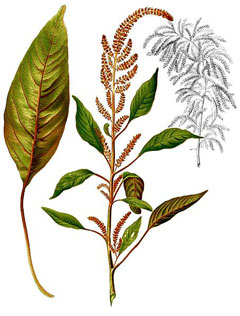
Purple Amaranth, Red amaranth
Latin Name: Amaranthus cruentus
USDA Hardiness: 3-11
Native Range: Coming Soon
Edibility Rating: 4 / 5
Medicinal Rating: 2 / 5
Region:
Family:
Plant Type:
Medicinal Uses
Edible Uses
Edible Parts: Leaves Seed | Edible Uses: ColouringLeaves - cooked as a spinach[183]. The mild-flavoured leaves are rich in vitamins and minerals[183]. Seed - very small but easy to harvest and very nutritious. They are eaten cooked or ground into a powder and used for making cakes etc[183, 257]. They can also be sprouted and used in salads[183]. The seed can be cooked whole, and becomes very gelatinous like this, but it is rather difficult to crush all of the small seeds in the mouth and thus some of the seed will pass right through the digestive system without being assimilated[K]. The flowers are used as a food colouring in ceremonial maize bread[183].
Cultivation
Prefers a well-drained fertile soil in a sunny position[200]. Requires a hot sheltered position if it is to do well[K]. Tolerates a pH in the range 4 to 7.5. Plants should not be given inorganic fertilizers, see notes above on toxicity. This species is cultivated for its edible seed in many parts of S. America and in Japan[58, 97, 183]. There is at least one named variety, 'Oeschberg' is a very productive plant, growing 1 metre tall and can yield up to 2.5 tonnes per hectare[183]. This species is the most adaptable of the grain amaranths, it also flowers under a wider range of daylength hours than the other species[183]. Most if not all members of this genus photosynthesize by a more efficient method than most plants. Called the 'C4 carbon-fixation pathway', this process is particularly efficient at high temperatures, in bright sunlight and under dry conditions[196]. In garden design, as well as the above-ground architecture of a plant, root structure considerations help in choosing plants that work together for their optimal soil requirements including nutrients and water. The root pattern is clumping, giving the plant a clumping habit. The predictable growth behaviour makes it easier to maintain without having to apply containment methods[2-1].
Known Hazards
No members of this genus are known to be poisonous, but when grown on nitrogen-rich soils they are known to concentrate nitrates in the leaves. This is especially noticeable on land where chemical fertilizers are used. Nitrates are implicated in stomach cancers, blue babies and some other health problems. It is inadvisable, therefore, to eat this plant if it is grown inorganically.
Habitats
Not known in a truly wild situation.
